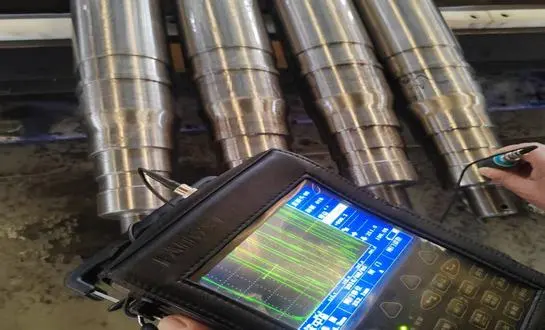The inspection of forged components involves a series of meticulous checks and measurements to ensure that the finished product meets the specified design requirements. This process is essential for industries that rely on high-performance components, such as automotive, aerospace, and oil and gas sectors. For shaft forging, these inspections are particularly critical as the shafts often serve as key components in machinery and equipment, where even minor deviations can lead to significant operational issues.
Non-destructive testing (NDT) methods for forged shafts
Visual Inspection Techniques
Visual inspection is often the first step in the quality control process for forged shafts. This method involves a thorough examination of the component's surface for any visible defects, such as cracks, seams, or surface irregularities. Inspectors use various tools, including magnifying glasses and borescopes, to examine hard-to-reach areas. While simple, this technique can be highly effective in identifying surface flaws that might affect the shaft's performance or indicate deeper structural issues.
Magnetic Particle Inspection
Magnetic Particle Inspection (MPI) is a widely used NDT method for detecting surface and near-surface discontinuities in ferromagnetic materials. In shaft forging, this technique is particularly valuable for identifying cracks, seams, and other defects that may not be visible to the naked eye. The process involves magnetizing the shaft and applying magnetic particles, which gather around any discontinuities, making them visible under special lighting conditions.
Eddy Current Testing
Eddy Current Testing (ECT) is another non-destructive method used in the inspection of forged shafts. This technique is especially useful for detecting surface and near-surface flaws in conductive materials. ECT works by inducing electrical currents in the material and analyzing the resulting electromagnetic field. Any disruptions in this field can indicate the presence of defects, making it an effective tool for quality control in shaft manufacturing.
How does ultrasonic testing detect flaws in forged components?
Principles of Ultrasonic Testing
Ultrasonic Testing (UT) is a sophisticated NDT method that uses high-frequency sound waves to detect internal flaws in forged components. This technique is particularly valuable in shaft forging inspections due to its ability to penetrate deep into the material. Ultrasonic waves are transmitted into the shaft, and the reflected signals are analyzed to identify any discontinuities or anomalies within the component's structure.
Types of Ultrasonic Testing Methods
There are several types of ultrasonic testing methods used in the inspection of forged shafts. The most common include pulse-echo, through-transmission, and phased array ultrasonic testing. Each method has its strengths and is chosen based on the specific requirements of the inspection task. For instance, phased array ultrasonic testing offers enhanced resolution and the ability to inspect complex geometries, making it particularly useful for intricate shaft designs.
Interpretation of Ultrasonic Test Results
Interpreting ultrasonic test results requires skill and experience. Technicians analyze the amplitude, shape, and timing of the reflected signals to determine the size, location, and nature of any defects within the forged shaft. Advanced software and imaging techniques are often employed to create detailed 3D representations of the internal structure, allowing for a comprehensive assessment of the component's integrity.
Tolerances and ISO standards for precision shaft forging
Understanding ISO Standards for Forging
ISO standards play a crucial role in defining the tolerances and specifications for precision shaft forging. These standards ensure consistency and quality across the industry, providing manufacturers and customers with a common framework for evaluating forged components. Key ISO standards relevant to shaft forging include ISO 7452, which specifies tolerances for hot-rolled steel plates, and ISO 1101, which outlines geometrical tolerancing principles.
Dimensional Tolerances in Shaft Forging
Dimensional tolerances are critical in shaft forging to ensure that the finished components meet the required specifications. These tolerances cover various aspects of the shaft's geometry, including diameter, length, straightness, and roundness. The specific tolerances depend on the shaft's application and the level of precision required. For high-precision applications, tolerances may be as tight as a few micrometers, requiring advanced measurement techniques and quality control processes.
Quality Control Measures and Documentation
Implementing robust quality control measures is essential in maintaining the required tolerances in shaft forging. This involves regular calibration of measurement equipment, thorough documentation of inspection results, and continuous monitoring of the manufacturing process. Many manufacturers employ statistical process control (SPC) techniques to track and improve the consistency of their forging operations. Proper documentation of these quality control measures is crucial for compliance with ISO standards and customer requirements.
In conclusion, the inspection of forged components for shape and dimensional accuracy is a critical aspect of quality assurance in manufacturing, particularly in shaft forging. By employing a combination of visual inspections, non-destructive testing methods, and adherence to strict ISO standards, manufacturers can ensure the production of high-quality, reliable shafts that meet the demanding requirements of various industries. As technology continues to advance, new inspection techniques and more precise measurement methods are likely to emerge, further enhancing the capabilities of quality control in forging operations.
For more information on precision shaft forging and advanced inspection techniques, please contact us at oiltools15@welongpost.com. Welong is committed to delivering high-quality forged components that meet the most stringent industry standards.





